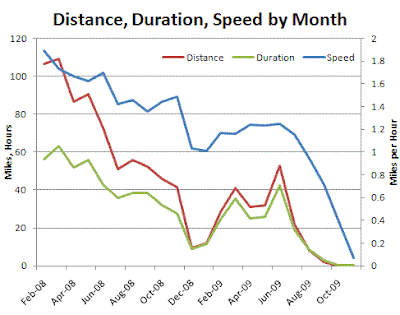About two years ago my housemates and I started wondering if our hamster, Lizzie, could run across the United States in her lifetime. I built a device to count revolutions of her wheel and a
website to track her status. Recently Lizzie passed away making it almost 1000 miles (or about a third) of her journey. We were sad to see her go, but she left some interesting data.
How far does a hamster run?
Over her recorded life, Lizzie ran an average of
1.65 miles per day. In the first half of her life this average was higher at 2.27 miles per day. Later in her life, as she started getting old and sick, it dropped to 0.88 miles.
As one might expect, over time she ran less and less per month. Below is a graph of the distance she ran each month, the amount of time she spent running, and her average speed.
There are a couple interesting insights in this graph.
- Lizzie ran a lot less in Dec-08 and Jan-09 (10 miles a month down from 40). We're not entirely sure what caused this but suspect it was some sort of pseudo hibernation. We know that we hadn't managed the heat well and there were a couple days when the temperature dropped inside the house which might have triggered this instinct. However she was still eating, drinking, and pooping fine.
- In the precipitous decline at the end of her life, she both ran more slowly and ran less. This is in contrast to her pseudo hibernation where she just spent less time running. This might be a way to tell if a hamster is unhealthy (if you're not already being a diligent pet owner).
When does a hamster run?
Anyone who's owned a hamster and has been kept up by the pitter patter of little hamster feet running on the wheel knows that they're nocturnal. This was confirmed by our observations. As seen below,
she runs almost exclusively at night.
I wish I had recorded light levels in her cage to see if the room lights and my roommate's sleep schedule) affected when she ran.
How fast does a hamster run?
Over her recorded lifetime she ran an average of
1.51 mph. This was higher when she was younger in 2008 at 1.62 mph and significantly lower as she got older in 2009 at 1.18 mph. Her top speed was about 2.5 mph.
This can also be graphed in interesting ways. Below shows how many miles he ran at each speed in 1/100th of a mph increments.
There's a spike at 0 mph which probably came from her starting and stopping, which she did a lot. In fact, if you were in the room watching her, she'd start and stop very often just to check if you were still there.
Looking rest of the graph, we see two peaks in the total (red line), almost as if she had two preferred speeds. It turns out that after whatever happened to her in the winter of '09, her preferred speed switched from 1.6 mph to 1.2 mph. Looking at the years by themselves (purple and green lines) we get something that looks a little closer to a bell curve (or some sort of distribution around a mean). Putting all three of these together we can see how 2008 and 2009 add to create the two peaks that we see in the total curve.
What's next?
Well the scientist in me would like to buy 5 more hamsters to see if these results are typical and measure more variables (like temperature, water consumption, and light levels). Realistically I think we're just going to get a new hamster to pick up where Lizzie left off. However, we are going to bury Lizzie's cremated remains where she stopped, in
Carson National Forest in the Spring.
If you have more questions, check out the
FAQ. Also, if you want to track your own hamster, I wrote an
Instructable you can follow.
Technologies: PHP, Python, MySQL, Google Docs











